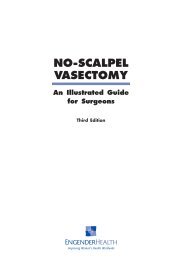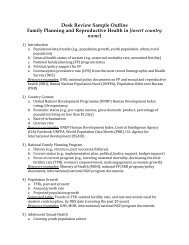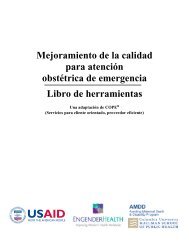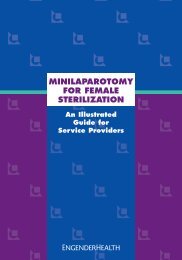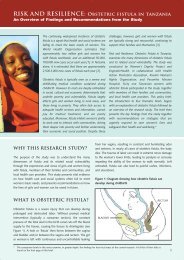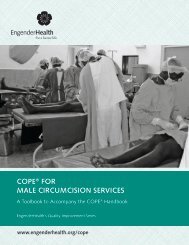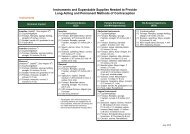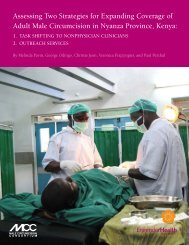Risk and Resilience: Obstetric Fistula in Tanzania - EngenderHealth
Risk and Resilience: Obstetric Fistula in Tanzania - EngenderHealth
Risk and Resilience: Obstetric Fistula in Tanzania - EngenderHealth
You also want an ePaper? Increase the reach of your titles
YUMPU automatically turns print PDFs into web optimized ePapers that Google loves.
Preparation for the Baby<br />
The majority of the women did not prepare for the<br />
baby <strong>in</strong> any way. One of the common reasons<br />
expressed was that prepar<strong>in</strong>g for a baby was<br />
aga<strong>in</strong>st their customs <strong>and</strong> that they wanted to wait<br />
until the baby was born because they did not<br />
know if the baby would be born alive. Accord<strong>in</strong>g<br />
to one woman, it is taboo <strong>in</strong> her ethnic group to<br />
make preparations before the baby is born. A<br />
m<strong>in</strong>ority of the women prepared for the baby <strong>in</strong><br />
some way, either by buy<strong>in</strong>g clothes for the baby,<br />
buy<strong>in</strong>g powder, <strong>and</strong>/or buy<strong>in</strong>g bleach to wash the<br />
baby’s clothes.<br />
D. Labor, Delivery, <strong>and</strong> Referral<br />
Trajectory<br />
Onset of Labor<br />
Nearly all of the women started labor at home; of<br />
these, the majority went <strong>in</strong>to labor <strong>in</strong> the even<strong>in</strong>g<br />
or at night, when it was more difficult to access<br />
assistance. A few started labor while outside the<br />
home, either while do<strong>in</strong>g chores, while at church,<br />
or while visit<strong>in</strong>g relatives. A few also started labor<br />
when they were <strong>in</strong> transit to the hospital or when<br />
they were already at the hospital.<br />
Delivery Trajectory<br />
Nearly all of the women who began their labor at<br />
home had to make at least one move. Their move<br />
was based on see<strong>in</strong>g that there was a delay or<br />
problem that needed appropriate care. Only seven<br />
women delivered where they started labor - five at<br />
home 8 <strong>and</strong> two at the hospital. Table 4 shows the<br />
number of moves made by women from the<br />
<strong>in</strong>itiation of labor until the delivery of the baby.<br />
Table 4: Number of Moves Made by Women from<br />
Initiation of Labour to F<strong>in</strong>al Delivery<br />
No. of moves No. of women<br />
0 7<br />
1 30<br />
2 19<br />
3 4<br />
>3 1<br />
Of the women who had to make a move to<br />
receive appropriate care, about half made only one<br />
move; of these women, nearly all went from their<br />
home to a hospital where they received the<br />
necessary help.<br />
Fewer than half of the women had to make at<br />
least two moves from the place where labor began<br />
to where they completed delivery. Among these<br />
women, nearly all had to go to a hospital before<br />
receiv<strong>in</strong>g appropriate care. (See Annex 2 for<br />
further details on where the women sought care<br />
after <strong>in</strong>itiation of labor.)<br />
Of the women who started their labor at home,<br />
fewer than half were assisted by a TBA, while the<br />
rest were generally assisted by family or friends. In<br />
two cases, women were assisted by communitybased<br />
providers (a pharmacy assistant <strong>and</strong> a nurse)<br />
who were not TBAs. Of those women who were<br />
assisted by a TBA, nearly all had to seek care<br />
elsewhere after experienc<strong>in</strong>g labor <strong>and</strong> delivery<br />
problems.<br />
Reasons for Mov<strong>in</strong>g<br />
The most common reason for mak<strong>in</strong>g the first move<br />
was because the woman or her family realized that<br />
substantial time had passed <strong>in</strong> labor without<br />
progress. The second most common reason was<br />
because the TBA realized she could not help. 9<br />
Who Made the Decision to Move<br />
The majority of women were helped by others to<br />
make the decision to move to another place for<br />
labor or delivery. Only five women with fistula<br />
made the decision to move dur<strong>in</strong>g labor totally by<br />
themselves. Once a woman was <strong>in</strong> labor, family<br />
<strong>and</strong> friends were the primary decision makers. Of<br />
these, the husb<strong>and</strong> was the most frequent decision<br />
maker, followed by the woman’s parents. In-laws<br />
<strong>and</strong> neighbors/friends also played a role <strong>in</strong> mak<strong>in</strong>g<br />
the decision to move the woman to another place<br />
for delivery. In one case, the woman experienced<br />
difficulty <strong>in</strong> gett<strong>in</strong>g to the hospital because of a<br />
family member; as she expla<strong>in</strong>ed: “I was delayed <strong>in</strong><br />
gett<strong>in</strong>g to the hospital because my mother-<strong>in</strong>-law<br />
wanted me to deliver at home.” (Patient at<br />
Bug<strong>and</strong>o, age 17)<br />
16<br />
8 Four of these women received help from TBAs.<br />
9 More detailed <strong>in</strong>formation related to the delivery process is offered <strong>in</strong> the next section.



